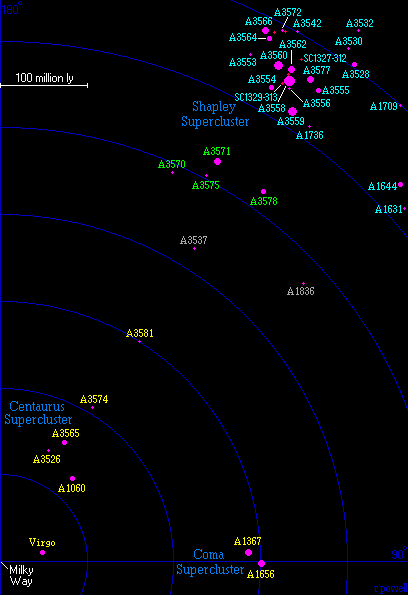http://en.wikipedia.org/wiki/Dark_flow wrote:
<<Dark flow is an astrophysical term describing a possible non-random component of the peculiar velocity of galaxy clusters. The actual measured velocity is the sum of the velocity predicted by Hubble's Law plus a small and unexplained (or dark) velocity flowing in a common direction.
Analyzing the three-year Wilkinson Microwave Anisotropy Probe (WMAP) data using the kinematic
Sunyaev-Zel'dovich effect, the authors of the study found evidence of a "surprisingly coherent" 600–1000 km/s flow of clusters toward a 20-degree patch of sky between the constellations of Centaurus and Vela.
The authors, Alexander Kashlinsky, F. Atrio-Barandela, D. Kocevski and H. Ebeling, suggest that the motion may be a remnant of the influence of no-longer-visible regions of the universe prior to inflation. Telescopes cannot see events earlier than about 380,000 years after the Big Bang, when the universe became transparent (the Cosmic Microwave Background); this corresponds to the particle horizon at a distance of about 46 billion light years. Since the matter causing the net motion in this proposal is outside this range, it would in a certain sense be outside our visible universe; however, it would still be in our past light cone. The results appeared in the October 20, 2008, issue of Astrophysical Journal Letters. Since then, the authors have extended their analysis to additional clusters and the recently released WMAP five-year data.
The dark flow was determined to be flowing in the direction of the Centaurus and Hydra constellations. This corresponds with the direction of the Great Attractor, which is a gravitational mystery originally discovered in 1973. However, the source of the Great Attractor's attraction was thought to originate from a massive cluster of galaxies called the Norma Cluster, located about 250 million light-years away from the Milky Way.
In a study from March 2010, Kashlinsky extended his work from 2008, by using the 5-year WMAP results rather than the 3-year results, and doubling the number of galaxy clusters observed from 700. The team also sorted the cluster catalog into four "slices" representing different distance ranges. They then examined the preferred flow direction for the clusters within each slice. While the size and exact position of this direction display some variation, the overall trends among the slices exhibit remarkable agreement. "
We detect motion along this axis, but right now our data cannot state as strongly as we'd like whether the clusters are coming or going," Kashlinsky said. The team has so far catalogued the effect as far out as 2.5 billion light-years, and hopes to expand its catalog out further still to twice the current distance.
Criticisms: Astrophysicist Ned Wright posted an online response to the study arguing that its methods are flawed. The authors of the "dark flow" study released a statement in return, refuting three of Wright's five arguments and identifying the remaining two as a typo and a technicality that do not affect the measurements and their interpretation. A more recent statistical work done by Ryan Keisler claims to rule out the possibility that the dark flow is a physical phenomenon because Kashlinsky et al. do not consider primary CMB anisotropies as important as they are. The existence and the velocity of dark flow will probably stay disputed until the new accurate cosmic microwave background radiation data by the European Space Agency's Planck satellite are available in 2012.>>



